Related Research Articles
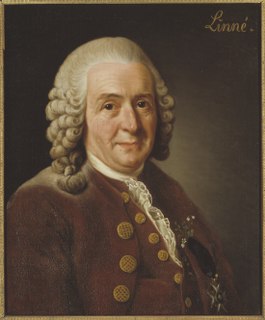
Carl Linnaeus, also known after his ennoblement as Carl von Linné, was a Swedish botanist, zoologist, and physician who formalised binomial nomenclature, the modern system of naming organisms. He is known as the "father of modern taxonomy". Many of his writings were in Latin, and his name is rendered in Latin as Carolus Linnæus.

Royal Botanic Gardens, Kew, is a non-departmental public body in the United Kingdom sponsored by the Department for Environment, Food and Rural Affairs. An internationally important botanical research and education institution, it employs 1,100 staff. Its board of trustees is chaired by Dame Amelia Fawcett.

Picris (oxtongues) is a genus in the sunflower family described as a genus by Linnaeus in 1753.

John Lindley FRS was an English botanist, gardener and orchidologist.
The 1893 Index Kewensis (IK), maintained by the Royal Botanic Gardens, Kew, is a publication that aims to register all botanical names for seed plants at the rank of species and genera. It later came to include names of taxonomic families and ranks below that of species.
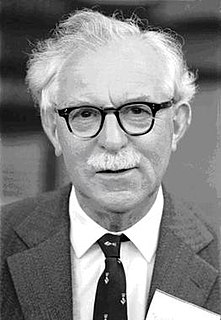
William Thomas Stearn was a British botanist. Born in Cambridge in 1911, he was largely self-educated, and developed an early interest in books and natural history. His initial work experience was at a Cambridge bookshop, but he also had a position as an assistant in the university botany department. At the age of 29 he married Eldwyth Ruth Alford, who later became his collaborator. He died in London in 2001.

Benjamin Daydon Jackson was a pioneering botanist and taxonomer who wrote the first volume of Index Kewensis to include all the flowering plants.
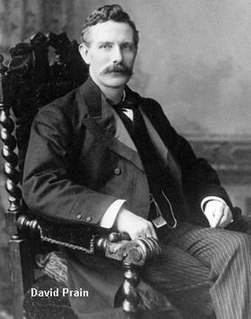
Sir David Prain was a Scottish physician remembered as a noted amateur botanist. He worked for many years in India working in the Calcutta Botanical Garden and involved in cinchona cultivation in Darjeeling.
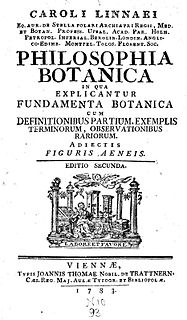
Philosophia Botanica was published by the Swedish naturalist and physician Carl Linnaeus (1707–1778) who greatly influenced the development of botanical taxonomy and systematics in the 18th and 19th centuries. It is "the first textbook of descriptive systematic botany and botanical Latin". It also contains Linnaeus's first published description of his binomial nomenclature.
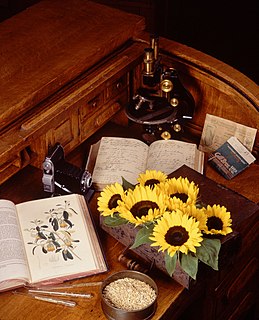
Cultivated plant taxonomy is the study of the theory and practice of the science that identifies, describes, classifies, and names cultigens—those plants whose origin or selection is primarily due to intentional human activity. Cultivated plant taxonomists do, however, work with all kinds of plants in cultivation.

Critica Botanica was written by Swedish botanist, physician, zoologist and naturalist Carl Linnaeus (1707–1778). The book was published in Germany when Linnaeus was twenty-nine with a discursus by the botanist Johannes Browallius (1707–1755), bishop of Åbo. The first edition was published in July 1737 under the full title Critica botanica in qua nomina plantarum generica, specifica & variantia examini subjiciuntur, selectoria confirmantur, indigna rejiciuntur; simulque doctrina circa denominationem plantarum traditur. Seu Fundamentorum botanicorum pars IV Accedit Johannis Browallii De necessitate historiae naturalis discursus.

Fundamenta Botanica was one of the major works of the Swedish botanist, zoologist and physician Carl Linnaeus (1707–1778) and issued both as a separate work and part of the Bibliotheca Botanica.

Flora Lapponica is an account of the plants of Lapland written by botanist, zoologist and naturalist Carl Linnaeus (1707-1788) following his expedition to Lapland.
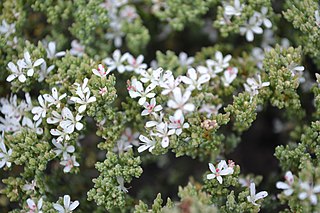
Frankenia is the only genus in the Frankeniaceae family of flowering plants. Other genera have been recognized within the family, such as Anthobryum, Hypericopsis and Niederleinia, but molecular phylogenetic studies have consistently shown that they all belong inside Frankenia. Frankenia comprises about 70–80 species of shrubs, subshrubs and herbaceous plants, adapted to saline and dry environments throughout temperate and subtropical regions. A few species are in cultivation as ornamental plants.
Thomas Archibald Sprague was a Scottish botanist. In 1938 he married botanist Mary Letitia Green, and together they authored several supplements to the Index Kewensis.
Stephen Troyte Dunn was a British botanist. He described and systematized a significant number of plants around the world, his input most noticeable in the taxonomy of the flora of China. Among the plants he first scientifically described was Bauhinia blakeana, the national flower of Hong Kong.
The Kew Rule was used by some authors to determine the application of synonymous names in botanical nomenclature up to about 1906, but was and still is contrary to codes of botanical nomenclature including the International Code of Nomenclature for algae, fungi, and plants. Index Kewensis, a publication that aimed to list all botanical names for seed plants at the ranks of species and genus, used the Kew Rule until its Supplement IV was published in 1913.

Elian Emily Collins was an English botanist, naturalist and an early collector of plant specimens in Thailand. She discovered several plant species new to science and had numerous species named after her.
Delia Abbiatti is an Argentinian botanist and pteridologist, noted for studying Eriocaulaceae, Loranthaceae, Thelypteris, and Cyclosorus. The species Perezia abbiattii and Thelypteris abbiattii were named in her honor. The standard author abbreviation Abbiatti is used to indicate this person as the author when citing a botanical name.
Lettice Digby was a British cytologist, botanist and malacologist. Her work provided the first demonstration that a fertile polyploid hybrid had formed between two cultivated plant species.
References
- ↑ "Green, Mary Letitia". Global Plants. JSTOR. Retrieved 16 September 2018.
- ↑ "Sprague, Mary Letitia (Manna) (1886-1978)". Global Plants. JSTOR. Retrieved 17 September 2018.
- ↑ "Index Kewensis chronology". International Plant Names Index. Retrieved 17 September 2018.
- ↑ Ogilvie, Marilyn Bailey; Harvey, Joy Dorothy (2000). The Biographical Dictionary of Women in Science: L-Z. Taylor & Francis. p. 1221. ISBN 9780415920407 . Retrieved 17 September 2018.
- ↑ "Tropicos | Person - Green, Mary Letitia (later Sprague)". www.tropicos.org. Retrieved 17 September 2018.
- ↑ IPNI. M.L.Green.
- ↑ Linnaeus, Carolus (1938). The "Critica Botanica" of Linnaeus. Translated by Hort, Arthur. Linnean Society of London.
| This article about a British botanist is a stub. You can help Wikipedia by expanding it. |